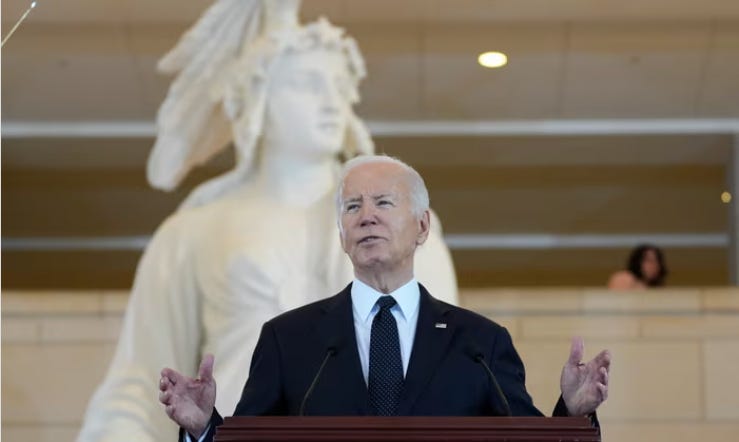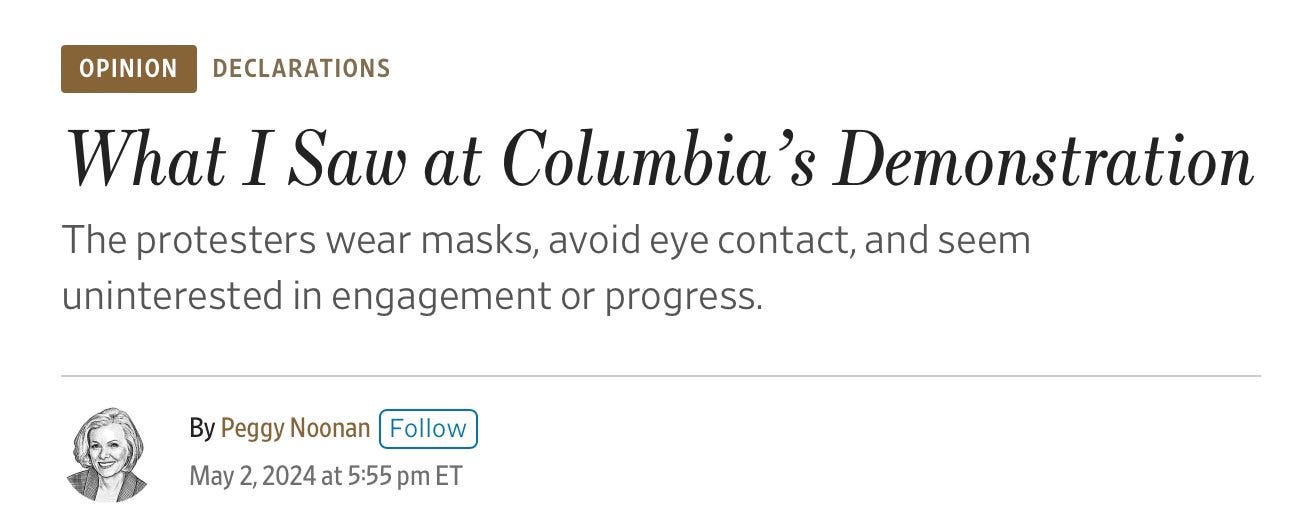Campus Protests Show the Left Learned from Occupy Wall Street
And the establishment is freaking out about it.
Occupy Wall Street was a lot like Y2K. While it energized the imagination of a different world, it came and went without any material change. The world didn’t end at midnight on January 1st, 2000, and when the last occupant left Zuccotti Park in November 2011, capitalism still reigned. Though Occupy had positive downstream effects, it is largely considered a failure. One of the organizers even wrote a book saying so.
Given this colossal missed opportunity, it’s inspiring to see the ongoing pro-Palestine campus protests have learned from past mistakes. By fixing what Occupy got wrong and replicating what it did right, collegiate protestors have built the most effective protest movement in modern American history. While protests may seem chaotic, we can identify four specific components that have led to the success of the encampment movement.
Clear Demands
If you were to stroll through Zuccotti Park in 2011 and ask any of the Occupy protestors what their demands were, you’d hear vague anti-capitalist platitudes about “ending income inequality” and “smashing the 1%.” These are great slogans, but they’re not demands. The Occupy organizers chose not to name specific goals, as they felt it would pigeonhole their movement and deter potential supporters. Though well-intended, this was a mistake.
Without clear demands, how do you know if you won? How do you build pressure to achieve an objective? You can’t, as your opponents can deflect and say “I don’t have the power to help you.” By stating clear demands for the colleges to divest from weapons manufacturers and Israeli companies, campus protestors are identifying specific action items that have identified decision-makers. If students demanded their schools “Free Palestine,” university presidents would rightfully reply, “I can’t do that.” But, as they have made objective requests that are within administrators’ control, everyone knows what they’re working towards and who to blame when the demands aren’t met.
Structure
Occupy was a horizontalist movement. All decisions were made by rudimentary democracy, via hand signals. This fostered paralysis, as every decision needed to be run through thousands of protestors instead of appointed leaders who could remain nimble. Additionally, the decentralized nature left Occupy vulnerable to media manipulation. Anyone and everyone spoke to the press, which, when coupled with unclear demands, resulted in muddled communications that made it easy to defame the movement. Mainstream reporters would quote the wackiest protestor they could find, making Occupy look like a silly encampment for vagabonds rather than a serious political project.
The students have reconciled this mistake by instituting structure into their encampments. To avoid press defamation, they’ve designated trained media spokespeople and instituted “don’t talk to press” rules for other participants. While mainstream reporters have been pearl-clutching for weeks about this “authoritarianism,” it’s exactly how other political bodies (such as parties and campaigns) operate. The foresight to avoid media misrepresentation and organize encampment structures shows the students are taking their movement with the seriousness it deserves.
Tactics
While Occupy was rife with failures, its greatest achievement was pioneering online organization. The first tweet to use #OccupyWallStreet was sent from California, but it quickly drove a global movement with #Occupy gatherings from New York to Seoul and everywhere in between.
Just like the millennials who composed Occupy, Gen Z student protestors have spent significant portions of their lives online. Not only is social media their primary information source, but they’re damn good at posting. Instagram, TikTok, and Twitter accounts have been invaluable to the encampments. A well-timed livestream or viral post relays their needs to their followers in the community, who quickly show up with food, sleeping bags, or bodies to protect the camps from police raids.
Another successful tactic the student organizers have used is the timeless approach of revolutionaries everywhere: escalation. While Occupy Wall Street was mostly confined to Zuccotti Park, students have evolved their protests. At first, they camped out on school lawns. When their camps were raided by the police, they matched the escalation by moving into administration buildings and study halls. Escalation is a key component of protests for several reasons. First, it keeps your movement in the news cycle, as media outlets love “BREAKING NEWS” as much as Texas cops like assaulting women too young to buy a beer. Second, it keeps your group united. Very few Columbia students would have agreed to occupy Hamilton Hall on day one, but after weeks of mistreatment, they were ready for the next step. The third (and perhaps most important) reason is that escalation re-centers a movement’s demands. Administrators might be able to ignore an encampment on the campus lawn, but they can’t ignore the occupation of a building. When they sic the cops on their own students and put them in the way of NYPD gunfire, the public begins to ask. “Why are administrators willing to endanger students to protect university investments?”

Legacy
While it failed to bring material change, Occupy succeeded in changing the political attitudes of an entire generation. While “We Are the 99%” is a poor demand, it’s emblematic of real suffering caused by the 2008 Great Recession. Seeing the widespread support for Occupy, millennials have internalized this anti-capitalist sentiment and become the least-conservative generation in history.

Already, pro-Palestine student protestors are focusing on their legacy. They’ve connected their movements with past social justice initiatives, such as the Civil Rights, Anti-Vietnam War, and Anti-Apartheid struggles. “Peoples’ libraries” filled with revolutionary literature are helping students see how their actions connect with the global liberation struggle. At our local encampment here in Denver, civil rights legend Angela Davis stopped by to share words of encouragement. Later that week, students were trained by local labor organizers on how to unionize their workplaces.
Much like Occupy set my generation on the path of economic equality, the pro-Palestine protests appear to be steering the younger generation towards a life of anti-imperialism, anti-colonialism, and anti-Zionism. As foreign policy has always been a weak spot for the American left, this awakening, along with everything else students are learning from each other, are priceless development likely to shape Gen Z’s — and American — politics for the next half-century.
Reactionaries Are Reacting
By adopting effective aspects of protest and discarding the ineffective, student encampments have produced the most constructive protest movement of my lifetime. With this growing effectiveness, comes the backlash from those who are threatened by growing grassroots power.
Since the first tents rose at Columbia, the President has tried to label them “anti-semitic,” a laughably bad faith claim considering the protestors are disproportionately Jewish and Joe Biden is Catholic.

The police, specifically the NYPD, have thrown everything at the wall to explain away the militancy of these protests, which rightfully adopted anti-cop attitudes. One NYPD spokesperson even went on Morning Joe (Biden’s preferred television program) to claim a bike lock was proof of “outside funding,” only for online investigators to point out it was the exact lock Columbia sold to its students.

Last, and certainly least, there is the media. Rightist pundits have printed thousand-word meltdowns about protestors’ media discipline, claiming encampments were “authoritarian.”
The Washington Post even suggested protestors should take down their encampments and invest in the weapons companies they sought divestment from, an idea so bad it sounds like a Nathan Fielder skit.
These outlandish reactions from the media, police captains, and the President of the United States should strengthen the resolve of the student protestors and all who support them. Establishment forces have adopted insane explanations not because they’re effective at diminishing the movement, but because the establishment has never faced such a formidable foe and is unsure how to react. Several colleges have already agreed to divest, while others have done irredeemable damage to their names by asking fascist thugs to beat the love of Israel into their students. As Americans continue to call for a ceasefire and begin to question their country’s blind loyalty to a foreign nation, it’s increasingly appearing like the campus encampment movement will be remembered as the catalyst that brought an end to America’s suicidal support for the colonization of Palestine.










I'd love to hear from people who lived through Occupy Wall Street. Do you see protest movements as having evolved? Or, do you think they're doomed for the same irrelevancy as Occupy?
Insightful